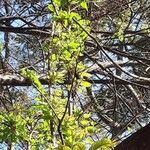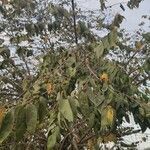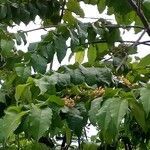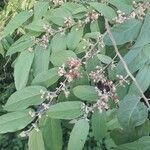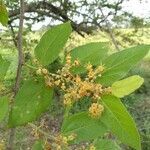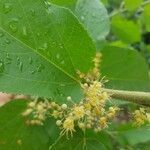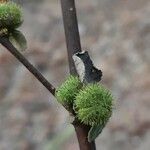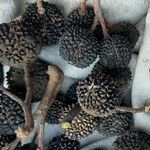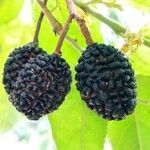Tree 2-25 m. in height, the trunk 5-60 cm. in diam., the young branches to-mentellous to puberulous. Leaves with a terete petiole 0.5-2 cm. long, tomentellous to puberulous, the stipules small and triangular, the blade ovate, ovate-oblong, oblong or seldom narrowly oblong, slightly to very much inaequilateral, rounded to cordate at the base, long-acuminate at the apex, ca. 6-16 cm. long and 2-6 cm. wide, membranous to chartaceous, sometimes subcoriaceous, the margins irregu-larly dentate to serrate, the upper surface shortly puberulous, seldom glabrous, gener-ally scabridulous and sometimes somewhat lustrous, the lower surface puberulous to tomentellous, the pubescence either of only appressed hairs or of appressed and spreading hairs, 3-to 7-nerved at the base, the nervation reticulate and prominent beneath. Inflorescences thyrsiform, the ultimate axes scorpioid, the axes and bracts densely puberulous to tomentellous. Flowers with a pedicel ca. 3-6 mm. long; calyx ca. 3 mm. in diam., divided irregularly into 3 lobes ca. 3 mm. long, densely puberulous to tomentellous outside and glabrous or nearly so inside; petals obovate, slightly bifid at the apex, ca. 4 mm. long (without appendage) and 2 mm. wide, the claw ca. 0.5-1 mm. long, the appendage ca. 5 mm. long and bifid for ca. 3 mm., yellowish, puberulous outside, glabrous inside; staminal tube 1.2-1.5 mm. long, glabrous outside, loosely puberulous and with simple hairs on the upper part inside, the filaments ca. 0.8-1 mm. long, the staminodes ca. 0.8-1 mm. long and loosely puberulous; anthers very small, reddish; ovary ovoid to globose, ca. 0.8-1 mm. long and 0.8 mm. broad, shortly puberulous especially on the upper half; style and stigma ca. 1-1.5 mm. long. Capsule oblong, oblong-ellipsoid to globose, rounded on both ends, 1.5-4 cm. long and 1.2-2.5 cm. broad, black at maturity, tuberculate, the tubercles short, stout and more or less pyramidal, puberulous when young, indehiscent (the tubercles separating irregularly at maturity to a greater or less degree), somewhat pulpy inside; seeds numerous, obovoid, ca. 2.5-3.5 mm. long and 1.8-2 mm. wide, the testa maculate.
More
A tall tree. It loses its leaves during the year. The bark is grey-brown and rough and cracked. The tree grows 12-20 m high. The crown is irregular and the branches droop. The leaves are 6-20 cm long and are unequal at the base. Leaves are hairy and have irregular teeth. The flowers occur in clusters. They are about 5 mm wide and yellow. They have 5 petals and a woolly appearance. There are thread like appendages at the top of the flowers. The fruit is a capsule which is round and green but turns black when ripe. The fruit is edible. There are several oval seeds in a sweet, edible, mucilage layer.
